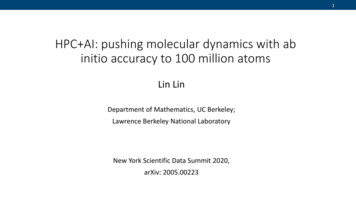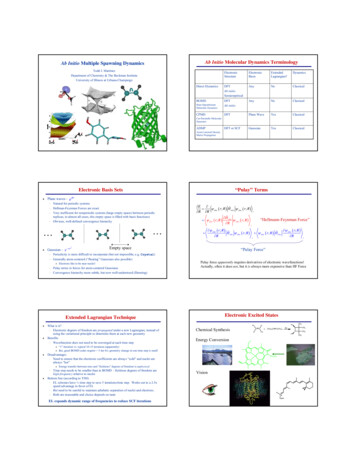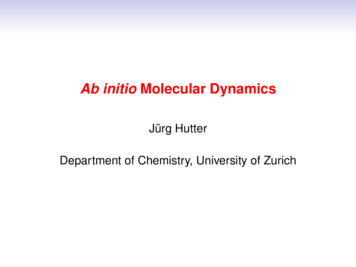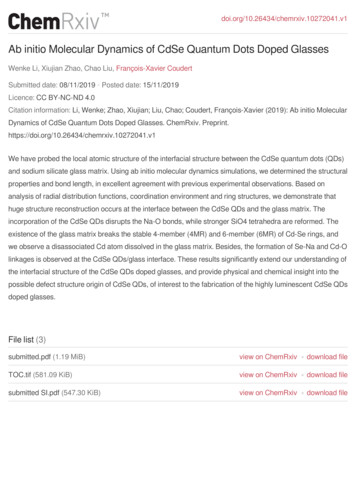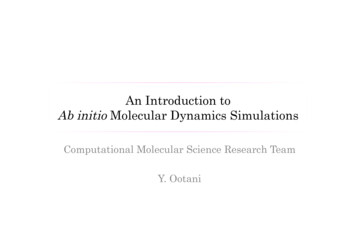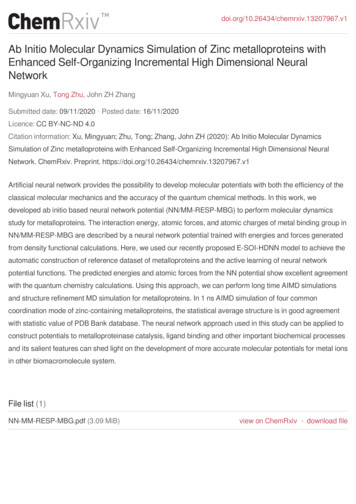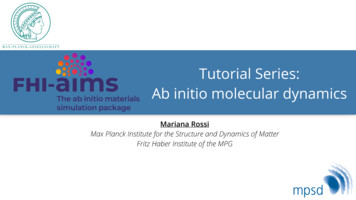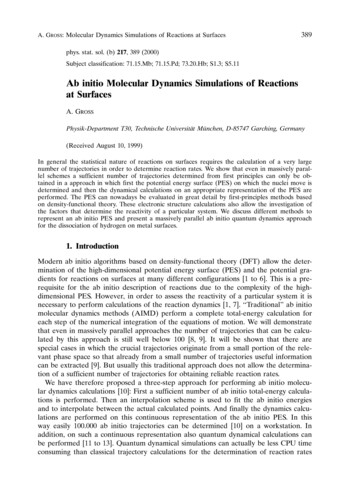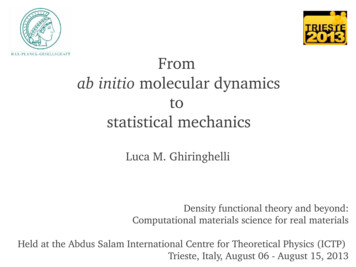
Transcription
Fromab initio molecular dynamicstostatistical mechanicsLuca M. GhiringhelliDensity functional theory and beyond:Computational materials science for real materialsHeld at the Abdus Salam International Centre for Theoretical Physics (ICTP)Trieste, Italy, August 06 August 15, 2013
Extending the scaleLength(m)1Potential EnergySurface: E{Ri}(3N 1) dimensons10 310 6E10 9{Ri}Thermodynamics:p, T, V, N, some qcontinuumMacroscopiclsitaregimeedeaverage overorm many atoms all processesMesoscopicessregimeescorinterplay amongpefew atomsprocessesormMicroscopicregimeelementary processes10 1510 910 31Time (s)
Extending the scalePotentialenergysurfaceFree energymethodFree energysurface(T,{qi})PES can be from: Ab initio Classical force field Toy modelsWhy free energy? Nature at equilibrium minimizes free energy, not energy (extended) phase equilibria ( μα μβ ) relative population of competing structures (nanoscale) rate of processes (via Transition State Theory)
Chemical energy conversion: catalysisReactant(s)Non-catalytic free-energy barrierFree DesorptionReaction coordinate Issues:Reaction rate: proportional to exp ( ΔF / kT)Selectivity: eliminate or at least reduce the undesired products
Transition rates from free energykinetic prefactorharmonic TSTIf(one of the Cartesian coordinates), then:
Entropy?density of statesI principle:I II principle, reversible transformations:E.g.:Everything we do not know:lack of information
Free energy, one quantity, many definitions Fundamental statistical mechanics thermodynamics linkClassical statistics (for nuclei):
Free energy, one quantity, many definitionsThermodynamicsif we can calculate E and write analytically on approximation for S for oursystem, we use this expression. Example: ab initio atomistic thermodynamics.Thermodynamic Integrationor similar derivatives that yield measurable quantities (in a computersimulation): one can estimate the free energy by integrating such relations.This is the class of the so called thermodynamic integration methods.
Free energy, one quantity, many definitions Probabilistic interpretation of free energy
Statistical mechanics: free energy as a probabilistic conceptWhat is energy? A mapping from 3N coordinates into one scalarLet's introduce:so that:Formal definition of a free energy:
Statistical mechanics, quantities derived from ZAverage energy:Heat capacity:
Statistical mechanics, quantities derived from ZEvaluation of pressure
Ensemble averages on discrete machinesIf canonical and ergodic sampling isperformed
Ergodicity?
The problem of free energy samplingBut:One cannot converge such a quantity! but one cannot measure it, either
Theoretical free energy evaluation: the zoo Analytic: ab initio atomistic thermodynamics Canonical sampling: thermodynamic integration Canonical sampling: thermodynamic perturbation Generalized sampling: biased sampling / biased dynamics Unbiased (canonical) sampling re weighting techniques Evaluation: Parallel (over densities)or Serial
Free energy: “physical” path thermodynamic integrationHow are free energies measuredexperimentally?: ideal gasParallel (over densities)
Free energy: “unphysical” path thermodynamic integrationLet us assume a mixed potential:How to choose the reference?
Case study: phase diagram of pure carbonRoad map: Calculation of change of Helmoltz free energy from chosenreference state to a particular (T,p) point, for each involved phase(what about overlooked phases?), by means of thermodynamicsintegration.Search for of all coexistence points at a given T between all pairs ofphases, via integration of equations of state P(ρ) and evaluation ofcrossing points (alternative: common tangent construction).Prolongation of coexistence line by Gibbs Duhem integration
Case study: phase diagram of pure carbonConsidered phases: diamond, graphite, and liquid(s)
Case study: phase diagram of pure carbonConsidered phases: diamond, graphite, and liquid(s)
Case study: phase diagram of pure carbonReference phasesSolid(s): Einstein solidα? Maximum resemblanceof harmonic and “real” potential
Case study: phase diagram of pure carbonConsidered phases: diamond, graphite, and liquid(s)Reference phasesLiquid: Lennard JonesHow to choose σ, ε ?Maximum resemblance betweenLJ liquid and “real”:alignment radial distribution function peaks
Case study: λ–ensemble sampling and integrationParallel (over λ)
Case study: integration of P(ρ) equations of stateParallel (over densities)
Case study: equating Gibbs free energiesDifference in slopes:difference in specificvolumesPressure [GPa]And then:Gibbs Duhemintegration Serial
Alternative method for finding phase coexistence via F(V)
Notable cases (at 0 K): Silicon (1980)Yin and Cohen, PRL 1980DFT with LDA functional
Notable cases (at 0 K): Cerium (2013)Casadei et al. PRL (2013)
Carbon phase diagramLMG et al. PRL 2005
Sparing CPU time: adiabatic switchStart again from two systems:
Sparing CPU time: adiabatic switchtime ?!?reversible?
Sparing CPU time: adiabatic switchSilicon(classical potential) Serial
Ab initio diamond melting lineWang et al. PRL 95,185701 (2005)
Beyond equilibrium: Jarzynski theoremClausius inequality:Jarzynski equality (1997!)
Jarzynski theorem: steered dynamicsvInefficient because: Better estimated with the cumulant:Parallel (over replicas)
Summary of thermodynamic integrations Thermodynamic integration, from reference to state/system of interestalong “physical” or “unphysical” paths Construction of accurate phase diagrams Speeding up: adiabatic switch Faster, non equilibrium: Jarzynski equality
Thermodynamic perturbationIf poor overlap: sequence of systemsParallel (over systems)
Thermodynamic perturbation1
Thermodynamic perturbation
Thermodynamic perturbationParallel (over systems)
Thermodynamic perturbationSystem 0: N 1 interacting particles, 1 ideal gas articleSystem 1: N interacting particlesmedium lowdensityQuestion: How would you callhighdensitybetween these two systems?
Thermodynamic perturbation: recycling dataNon Boltzmann sampling,or the pleasure of multiplying by 1 and see what happens11
Non Boltzmann samplingGreat, but.
Umbrella sampling
Umbrella sampling (multiplying by 1 few more times.)Parallel(over biasing potentials)
Umbrella samplingBest choiceNot practical,want to calculate!is what we
Time dependent hamiltonian: MetadynamicsAlessandro Laio & Michele Parrinello, PNAS (2002) A method to “drive” chemical reactions using collective variables Add a small, repulsive potential at the present value of the reactioncoordinate Free energy surface can be reconstructed after the simulation
Time dependent hamiltonian: MetadynamicsAlgorithm Choose a set of collective variables, e. g. distances, coordinationnumber, simulation cell parameters, . . . Constraint these collective variables at a given point in s Perform “metadynamics” in space of collective coordinates. . .(choice is crucial!)
Time dependent hamiltonian: MetadynamicsHistory dependent potential:– either in steps: “coarse grained dynamics” – continuously: “smooth metadynamics”
Metadynamics: reconstruction of free energy profileThe free energy surface can be reconstructed afterwards!Slowly all the local minima are filled and Serial, but .
Metadynamics: pros and consAdvantages: Can cope with high dimensionality Predictive, wide exploration of free energysurface (with lower resolution)Disadvantages: Careful choice of the collective variables Inaccurate if a “slow” variable is forgotten(but this can be checked a posteriori) Choice of good (optimal) parameters(masses, coupling constants, . . . ) notstraightforward What happens if a single reaction coordinate is not enough?The low energy path might not be captured
ceptParallelT4T3T2T1Energy distributionT1T2.TNsomeEnergy (arb. units)coordinatesExchange rule, ensuring canonical sampling at all temperatures:
T4T3T2Swap2MD run 3Swap1MD run 2T5MD run 1ParallelParallel tempering:tempering: thethe implementationimplementationParallel(over replicas,and more)T1To be tuned for efficient sampling:number of temperatures, list of temperatures, attempted swap frequency
Parallel tempering: free energy?T Weighted Histogram Analysis Method:, in case:Iterative, self consistent solution of:IMPORTANT: “q“ is a “post production“ (collective) variable
After parallel tempering: refinement of free energyUmbrella Sampling (Weighted Histogram Analysis)More efficient: Replica Exchange Umbrella Sampling
0.00 eV 0.04 eV0.36 eVPotential Energy (eV)Au4: coexistence of several isomers100—620 K100 K PT (100 ps)100 K serial (100 ps) (degree)
ProbabilityPartition Function(integrated probability)Free Energy [eV]Au4, relative population (T-WHAM)Angle [degree]Angle [degree] 0.00 eV 0.04 eV(PBE vdW)
Au4, relative population, coordination based descriptor
Final remarks We should be “afraid” of long inherently serial (force&energy) evaluations We should NOT be afraid of (shamefully) parallelizable, schemes, ascomputationally demanding as they can be Unbiased sampling (importance of not wasting anything) Reduction to relevant dimensions a posteriori Open system (grand canonical ensemble) within MD framework?
Free energy methods: accessibility via FHI aimsParallel tempering:home tailored script based implementationMetadynamics, Umbrella Sampling, Steered Dynamicsexternal plug in PLUMEDhttp://merlino.mi.infn.it/ plumed/PLUMED/Home.htmlReplica Exchange Umbrella Samplinghome tailored script external plug in PLUMEDSee microtutorial !!!Weighted Histogram Analysis WHAM/WHAM.html
ab initio molecular dynamics to statistical mechanics Density functional theory and beyond: Computational materials science for real materials Held at the Abdus Salam International Centre for Theoretical Physics (ICTP) Trieste, Italy, August 06 August 15, 2013 Luca M. Ghiringhelli. Extending the scale {R i} E Potential Energy Surface: E{R i} (3N 1) dimensons 10 9 10 6 10 3 1 10 15 .

